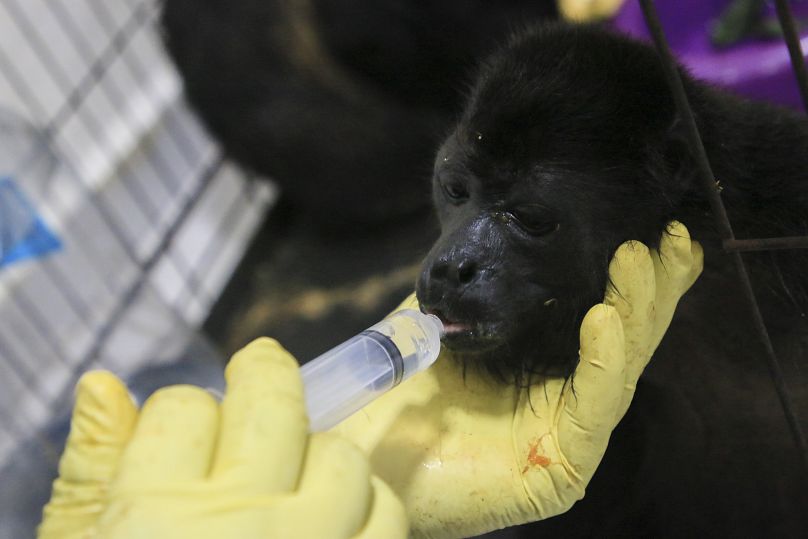Meteorologists explain the phenomenon behind the unseasonally hot temperatures.
Across the world, heatwaves are happening more often, lasting for longer and the temperatures are becoming more dangerous with each year, especially for vulnerable people.
Now, heatwaves are happening in Europe even earlier than in previous years.
Greece has already had their first heatwave of the year, leading to the deaths of tourists. Italy, Hungary and Türkiye are also baking in extreme weather.
Meteorologists say that the hot temperatures we have to suffer through are due to heat domes. But what are they and how can we keep ourselves safe in hot weather?
What is a heat dome?
Think of a heat dome as what’s happening in the atmosphere. When a high pressure system develops in the upper atmosphere, it causes the air below it to sink and compress. That raises temperatures in the lower atmosphere.
Because hot air expands, it creates a bulging dome, trapping heat within it.
Winds are usually able to move high pressure around but with the dome stretching far into the atmosphere, these weather systems become almost stationary.
A heat dome can lead temperatures to soar well above what is normal.
On top of this, the ground begins to warm up, losing moisture and increasing the chance of wildfires.
Are heatwaves becoming more common?
Since 1950 heatwaves have increased in length and frequency all over the world, as shown in a study published in 2020.
This research, carried out by scientists from UNSW Sydney and UNSW Canberra, found that the Mediterranean has experienced an increase of two and a half heatwave days per decade since 1950. The Amazon rainforest had an extra five and a half in the same period.
The worst increases globally have taken place since 1999.
Heatwaves increase the chance of prolonged droughts and the risk of wildfires.
There are health costs too. 2023's exceptionally hot and dry summer is estimated to have caused tens of thousands of heat-related deaths in Europe.
The consequences will be even more severe for cities, where the combination of buildings plus pavement plus concrete creates an ‘urban heat island’.
In Europe 75 per cent of the population lives in urban areas, making heatwave mitigation a pressing concern. What are the best ways that cities can be heatproofed?
We’ve listed the top three strategies for reducing the effects of heatwaves and added three ways that you can handle the heat. Our personal methods all have an environmental focus.
What can your government do to help with the heat?
Tree planting
A study published in 2019 found that increasing tree cover in cities could dramatically lower temperatures. Whereas surfaces like roads absorb heat, trees cool their surroundings through transpiration: absorbing water through their roots and releasing it into the atmosphere. It was found that for the best effects canopy cover must be 40 per cent.
Barcelona - already famous for its tree cover at 25.2 per cent - has a 20-year master plan to grow that to 30 per cent by 2037. This a wise move as southern Europe is expected to suffer from increasing heatwaves as climate change increasingly takes hold.
Adding vegetation to buildings
Trees aren’t the only plant-based solution on the block with an increased focus on adding vegetation to buildings as a way of cooling them down. Like trees, plants reflect the sun’s rays - a benefit if they are placed over heat-absorbing concrete - and cool the atmosphere through transpiration.
Urban planting schemes are underway in Paris and designs have been pioneered in Italy by architect Stefano Boeri.
Water features
While fountains may seem like a luxury they can have amazing cooling effects in urban environments.
Water absorbs and can transport heat (making moving fountains better than stagnant ponds for reducing temperatures), provides drinking water for parched citizens and decreases air temperature through evaporation.
The City of London's adaptation plan includes building more fountains and in Thessaloniki, Greece, Chrimatistiriou Square has a bioclimatic design with water features to provide relief from the sweltering Mediterranean heat.
What can you do to keep cool during a heatwave?
Wear natural fibres
Clothes made from fabric containing microplastics release harmful chemicals into the ocean when washed and can harm marine life.
The good news is that breathable clothing made from natural fibres like cotton and linen can keep you cool and is better for the fish. While far from perfect in terms of production, natural fibres do biodegrade and their weaves absorb sweat and allow air circulation around the body, helping to keep you cool.
Cold peppermint tea
First things first - ditch the coconut water. While this may seem like a natural beverage containing many hydrating electrolytes, coconut farming is deeply damaging to tropical biodiversity.
Switch to the far more ethically farmed peppermint tea. Mint can be grown in many different climates and can even be sourced locally or grown in your back garden. A peppermint teabag in a glass of cold water will cool you down as the natural menthol will stimulate cold receptors in the body.
Create a cross breeze
A more environmentally friendly option than air conditioning is to create a cross breeze using a fan and an open window.
Position the fan across the room from the window and the cooling airflow created will make sure you get a good night's sleep. For really hot nights place a frozen water bottle in front of the fan, and then you can enjoy a cold bottle of water when you wake up in the morning.












